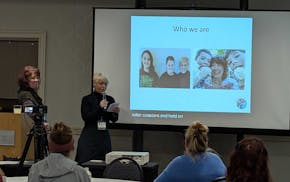Imagine traveling 30 years back in time to the day you sent your first e-mail message. Do you remember your excitement as you sat before that black screen with its blinking amber cursor and you typed your first words, correcting typos by simply backspacing over them, and then sending your message and receiving an immediate response?
What a thrill. What a kick. Such amazing technology. How did we ever get along without it?
Laboriously, is the answer. Back in the 1950s and 1960s, we sometimes retyped an entire page to correct a single typo if we didn't like the smudge left by typewriter erasers or the painted-over look of correction fluid.
When the IBM Correcting Selectric was introduced in 1973, we rejoiced over the ease with which we could backspace and deploy a separate correction ribbon that either covered the offending letter or lifted it from the paper when we retyped over it. Extraordinary.
But with the advent of e-mail, everything changed, and with those changes came fundamental shifts in our approach to written communication.
Our initial response to this emerging technology was anything goes. Although it had never been easier to correct and revise our text, why bother? Speed was everything. We were mesmerized by our ability to send messages and receive nearly instantaneous responses. Close attention to the rules of language went out the window.
Phase 2 in the history of e-mail usage began when we realized that correct spelling, grammar and punctuation counted after all, reflecting as they did both on the individual and on the organization. But everything had to be brief. If a message were longer than a page, we might just as well mail it.
And then came Phase 3. With the advent of another extraordinary technological breakthrough — the attachment — everything changed once more. Now we could send a document of any length, and the message itself served as a cover letter or executive summary that said in so many words: "Dear reader, when you read this long attachment, whatever you do, don't miss these key points."
Unbound, unfettered by length limits, we rejoiced. We now possessed both speed and bulk. OMG. And with this advance, we traveled back to the future. We rediscovered the value of the old-fashioned executive memo.
The format was as simple as the three-step paragraph (topic, development, resolution), and yet so powerful:
1. Purpose (I am writing to you because …)
2. Background (The important points are …)
3. Proposed action (I propose that you …)
Implicit with this summary was the recognition that not every reader would read every word or every attachment — we hoped they would, but they probably wouldn't, and in case they didn't, here were the main points, here in a few carefully chosen words was the distillation of our thought for the hurried reader, here it was with clarity, decisiveness and direction. Dear reader, here's why I'm writing, these are the facts and here's what I want you to do.
So clean, so direct, so simple.
Stephen Wilbers offers training seminars in effective business writing. E-mail him at wilbe004@umn.edu. His website is www.wilbers.com.

U.S. Bancorp executive stopped responding to control tower minutes before Brooklyn Park crash

Minneapolis condo in historic Midtown Exchange building listed for $205,000

RFK Jr.'s controversial comments draw ire at Minnesota autism convention

Big medical expenses drove $176 million operating loss last year at Medica

